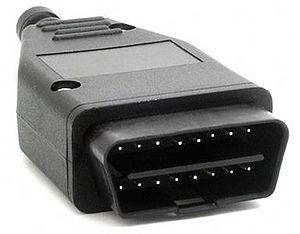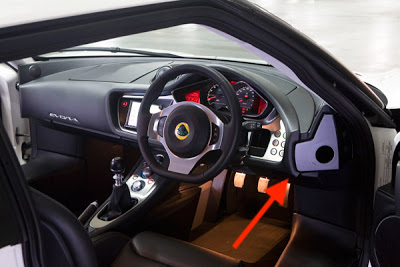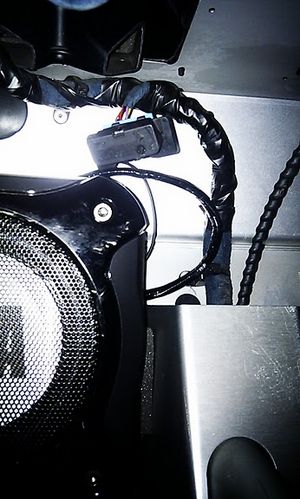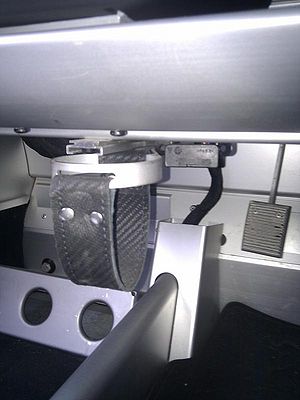On board diagnostics
Like all cars, the Elise is fitted with an On board diagnostic, or OBD, connector (socket) tucked away in the passenger foot well.
This can be used to communicate with the cars ECU for retrieving diagnostic information, resetting the MIL or viewing live engine parameters.
NOTE: This is only valid for the Elise S2/Exige S2. The Elise S1 and Exige S1 is equipped with a similar connector, but this connector is NOT OBD compatible!
The standard is also referred as: -
- OBD2
- OBD-2
- OBDII
- OBD-II
In europe the standard is called: -
- E-OBD
- EOBD
In practice it's very close to the USA-based OBD2 standard and most OBD2 scanners will work. The meaning of some of the codes in EOBD are slightly different from OBD2 though.
Port Location
Evora
On a cable that hangs down under the dash on the drivers side or (passenger side on left hand drive cars).
Fixed to the aluminium crossmember, pointing down, just past the point where the dash leather stops in the footwell, you should be able to feel it without stretching forward too much from the driving position.
DIY
On the S2 Elise it is quite simple to connect to the cars ECU yourself.
Until 2008 all S2's can be queried using the ISO 9141-2 OBD II protocol for the OBD required error codes and results. From 2008 onwards CAN is the only permitted OBD2 protocol.
All S2 variants also have a CAN bus connection on the same diagnostic connector.
For the Rover powered S2 variants the CAN bus is only connected to the engine ECU and used by the Lotus scan tool to reflash/upgrade the ECU and obtain the ECU dump information at the first service.
The dash unit still uses discrete inputs for the various gauges and information readouts, either connecting directly to sensors or using PWM signals from the ECU.
The Toyota powered S2 (111R, Fed-Elise, Exige2) also connects the CAN bus (running at 1 megabit/s) to the dash unit and does away with most of the discrete inputs to the dash unit, RPM, speed, MIL/CEL, coolant temperature and fuel level are supplied via the CAN Bus, the rest are discreete inputs.
The ScanTool3 provides the ECU reflash and DUMP via the K line, using the L line as an enable latch, the CAN bus is not used for reflashing or ECU dump, though it can be used by Lotus with their internal EFi supplied mapping tools.
OBD-II codes
OBD-II codes consist of a number of parts. Here is a sample OBD2 code:
P0171
Here is a breakdown of what each digit of the code means:
First Character - System The first character identifies identifies the system related to the trouble code.
P = Powertrain
B = Body
C = Chassis
U = Undefined
Second Digit - Code Type The second digit identifies whether the code is a generic code (same on all OBD-II equpped vehicles), or a manufacturer specific code.
0 = Generic (this is the digit zero -- not the letter "O")
1 = Enhanced (manufacturer specific)
Third Digit - Sub-System The third digit denotes the type of sub-system that pertains to the code
1 = Emission Management (Fuel or Air)
2 = Injector Circuit (Fuel or Air)
3 = Ignition or Misfire
4 = Emission Control
5 = Vehicle Speed & Idle Control
6 = Computer & Output Circuit
7 = Transmission
8 = Transmission
9 = SAE Reserved
0 = SAE Reserved
Fourth and Fifth Digits These digits, along with the others, are variable, and relate to a particular problem. For example,a P0171 code means P0171 - System Too Lean (Bank 1).
See Also
http://forums.seloc.org/viewthread.php?tid=112517
External Links
General Information
http://en.wikipedia.org/wiki/On_Board_Diagnostics
http://www.obdii.com/obdii.asp



